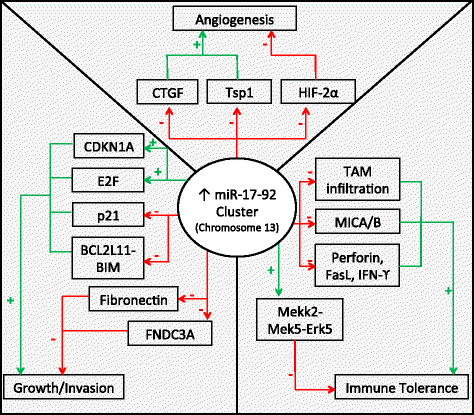Essential role of miRNAs in orchestrating the biology of the tumor microenvironment
- PMID: 27231010
- PMCID: PMC4882787
- DOI: 10.1186/s12943-016-0525-3
Essential role of miRNAs in orchestrating the biology of the tumor microenvironment
Abstract
MicroRNAs (miRNAs) are emerging as central players in shaping the biology of the Tumor Microenvironment (TME). They do so both by modulating their expression levels within the different cells of the TME and by being shuttled among different cell populations within exosomes and other extracellular vesicles. This review focuses on the state-of-the-art knowledge of the role of miRNAs in the complexity of the TME and highlights limitations and challenges in the field. A better understanding of the mechanisms of action of these fascinating micro molecules will lead to the development of new therapeutic weapons and most importantly, to an improvement in the clinical outcome of cancer patients.
Keywords: Cancer; Exosomes; Tumor microenvironment; microRNAs.
Figures

Similar articles
-
The role of exosomes in tumor progression and metastasis (Review).Oncol Rep. 2016 Mar;35(3):1237-44. doi: 10.3892/or.2015.4507. Epub 2015 Dec 22. Oncol Rep. 2016. PMID: 26707854 Review.
-
microRNAs in the tumor microenvironment: solving the riddle for a better diagnostics.Expert Rev Mol Diagn. 2014 Jun;14(5):565-74. doi: 10.1586/14737159.2014.922879. Expert Rev Mol Diagn. 2014. PMID: 24844135 Review.
-
Non-coding RNAs shuttled via exosomes reshape the hypoxic tumor microenvironment.J Hematol Oncol. 2020 Jun 5;13(1):67. doi: 10.1186/s13045-020-00893-3. J Hematol Oncol. 2020. PMID: 32503591 Free PMC article. Review.
-
Cancer-derived exosomic microRNAs shape the immune system within the tumor microenvironment: State of the art.Semin Cell Dev Biol. 2017 Jul;67:23-28. doi: 10.1016/j.semcdb.2016.12.004. Epub 2016 Dec 9. Semin Cell Dev Biol. 2017. PMID: 27956165 Free PMC article. Review.
-
MicroRNAs in the tumour microenvironment: big role for small players.Endocr Relat Cancer. 2013 Aug 23;20(5):R257-67. doi: 10.1530/ERC-13-0119. Print 2013 Oct. Endocr Relat Cancer. 2013. PMID: 23878074 Review.
Cited by
-
Selenium targets resistance biomarkers enhancing efficacy while reducing toxicity of anti-cancer drugs: preclinical and clinical development.Oncotarget. 2018 Jan 23;9(12):10765-10783. doi: 10.18632/oncotarget.24297. eCollection 2018 Feb 13. Oncotarget. 2018. PMID: 29535842 Free PMC article. Review.
-
Establishment and Characterization of a Human Small Cell Osteosarcoma Cancer Stem Cell Line: A New Possible In Vitro Model for Discovering Small Cell Osteosarcoma Biology.Stem Cells Int. 2016;2016:3042198. doi: 10.1155/2016/3042198. Epub 2016 Aug 29. Stem Cells Int. 2016. PMID: 27651797 Free PMC article.
-
Exosomal MicroRNAs in Breast Cancer towards Diagnostic and Therapeutic Applications.Cancers (Basel). 2017 Jun 24;9(7):71. doi: 10.3390/cancers9070071. Cancers (Basel). 2017. PMID: 28672799 Free PMC article. Review.
-
Epigenetic crosstalk between hypoxia and tumor driven by HIF regulation.J Exp Clin Cancer Res. 2020 Oct 27;39(1):224. doi: 10.1186/s13046-020-01733-5. J Exp Clin Cancer Res. 2020. PMID: 33109235 Free PMC article. Review.
-
Mesenchymal Stem Cell-Derived Exosomes as Drug Delivery Vehicles in Disease Therapy.Int J Mol Sci. 2024 Jul 14;25(14):7715. doi: 10.3390/ijms25147715. Int J Mol Sci. 2024. PMID: 39062956 Free PMC article. Review.
References
Publication types
MeSH terms
Substances
Grants and funding
LinkOut - more resources
Full Text Sources
Other Literature Sources

